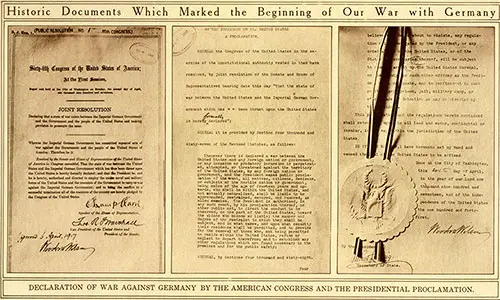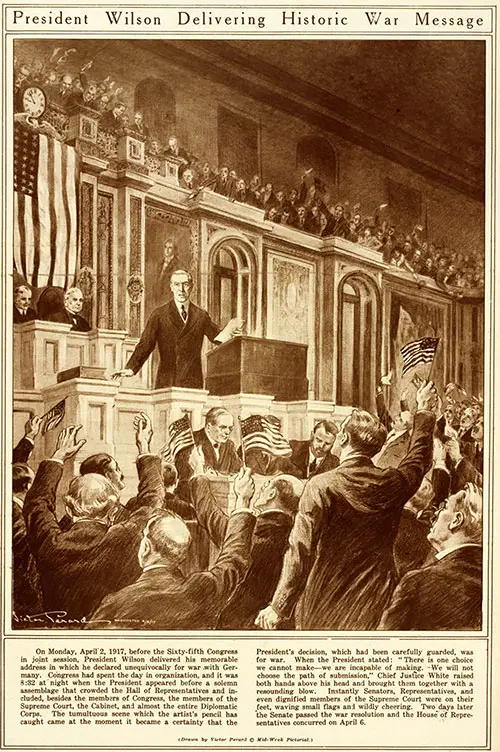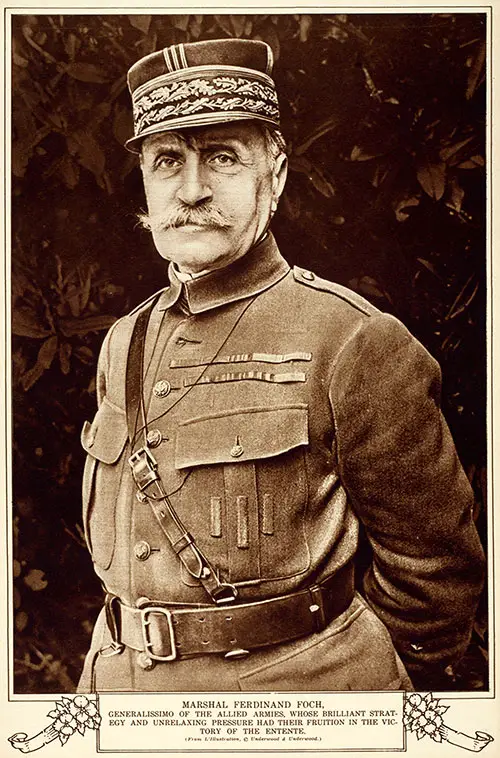America Joins the War - 1917

Historic Documents Which Marked the Beginning of Our War with Germany. Declaration of War Against Germany by the American Congress, and the Presidential Proclamation. The War of the Nations, New York Times, 1919. GGA Image ID # 195bcbf5a5
Most important of all the events of 1917 was the addition of the United States to our allies. From February 1 onwards, the Germans declared an "unrestricted submarine campaign," by which all shipping, trading with any of the allied nations, was sunk at sight.
This policy was intensely resented by the Americans, already aggrieved by the loss of many American ships and seamen and by the plots of the Austrian and German embassies at Washington. It required gross blundering on the Germans' part to force America to abandon her long tradition of abstention from European politics.
The American President, Woodrow Wilson, wisely allowed matters to move slowly, so that when the Germans had filled up the cup of their offenses, it was at the head of a united nation that, on April 6, 1917, he declared war. Like Britain, America set to work, with extraordinary success, to make a great army.

President Wilson Delivering Historic War Message. On Monday, April 2, 1917, before the Sixty-fifth Congress in joint session, President Wilson delivered his memorable address in which he declared unequivocally for war with Germany. Congress had spent the day in the organization. It was 8:32 at night when the President appeared before a solemn assemblage that crowded the Hall of Representatives and included, besides the members of Congress, the Supreme Court members, the Cabinet, and almost the entire Diplomatic Corps. The tumultuous scene which the artist's pencil has caught came when it became a certainty that the President's decision, which had been carefully guarded, was for war. When the President stated: "There is one choice we cannot make—we are incapable of making. We will not choose the path of submission," Chief Justice White raised both hands above his head and brought them together with a resounding blow. Instantly Senators, Representatives, and even dignified Supreme Court members were on their feet, waving small flags and wildly cheering. Two days later, the Senate passed the war resolution, and the House of Representatives concurred on April 6. Drawing by Victor Perard © Mid-Week Pictorial. The War of the Nations, New York Times, 1919. GGA Image ID # 195bc07001
The submarine menace was shown to be illusory when hundreds of thousands of American soldiers were safely convoyed across the Atlantic. The adhesion of America was much more than a compensation for the collapse of Russia.
It was the more valuable since America joined the war, as her President said, "to make the world safe for democracy." It was more apparent than ever that the war was a fight for freedom and right against autocracy and might.
The Great German Offensive, March-May 1918
The beginning of 1918 saw the allies weakened by their recent offensive and the Germans strengthened by fresh troops and cannon from the east. The Germans' game was now, as in 1914, to strike hard and quickly before the Americans arrived in force.
The first step of a general German offensive began on March 21, when the fifth British army's thin line, between the Sensee and Saint-Quentin, was broken through.
In a few days, the Germans were back in the old Battlefields on the Somme and Annie and pushed their advance to within a few miles of Amiens so that there was danger of their working down the Somme to the sea and cutting off the British from the French.
Others followed this serious blow. Though the British front at Arras stood firm, the Germans farther north nearly drove a wedge between the British in Flanders and their army in Artois. Against the French, the Germans advanced down the Oise nearly to Compiegne. Finally, a successful offensive farther east brought them from the Aisne to beyond the Marne. It was a crisis, almost as acute as that of Sept. 1914.
The Unity of Command
It was well that France's resisting power was still great, while that of Britain had been multiplied tenfold. All the threatened armies made a surprising recovery. In their offensive, the Germans had abandoned the indecisive war of trenches, but the allies soon learn to meet their new tactics and to improve upon them.
The allied soldiers had never failed in courage and hopefulness; the real difficulty was that each army had acted as a separate unit and that there had been no single directive mind to plan and order the whole campaign.
At this crisis, Lloyd George once more showed rare insight and leadership. He insisted that a single general should be appointed to co-ordinate and direct the whole of the allied armies.
Undaunted by the resignation of both the Chief of the British General Staff and the British War Minister, he persevered until he gained his point. Marshal Foch was chosen as the generalissimo of all the British and French armies, the British Commander, Sir Douglas Haig, who had succeeded French, loyally falling in with the new situation.
For the first time, a concerted plan of campaign was executed to meet the German attack. The Germans made no more progress. Amiens was saved, and Paris preserved from danger. Meanwhile, the armies were strengthened and reorganized; and hundreds of thousands of fresh Americans took up their posts beside their war-worn allies.
Foch Turns the Western Tide, July-September 1918

Marshal Ferdinand Foch, Generalissimo of the Allied Armies, Whose Brilliant Strategy and Unrelaxing Pressure Had Their Fruition in the Victory of the Entente. From L'illustration. © Underwood & Underwood. The War of the Nations, New York Times, 1919. GGA Image ID # 1957494037
Foch bided his time, but by the middle of July, he began his counter-offensive, and the whole situation changed as if by magic. Swinging blows were dealt against the enemy, now on one part of the line, then on another.
Over-strained by their great effort of the spring, the Germans had few fresh resources to meet the new danger. They still fought magnificently, but their new methods were bettered and turned against them.
The first stage of Foch's campaign was the second battle of the Marne, fought under similar conditions to those of the first Marne battle of 1914. The two sides of the German salient towards the Marne have attacked with such success that the French were back on the Aisne by the end of July.
Meanwhile, the French moved slowly up the Oise, while between Ypres and the Somme, the British fought their way eastwards with almost uniform success. In August, the pace was quickened, and it became more rapid with each succeeding month. By the end of September, the line of 1917 was more than restored.
The Submission of Turkey and Bulgaria in 1918
Meanwhile, there was even more rapid progress in the East. In Mesopotamia, Maude died in the midst of his triumphs; but his successor, General Marshall, pushed northwards towards Mosul. In Palestine, Alienor, a born cavalry leader, out-maneuvered the Turks by rapid sweeps of his great force of Indian, Colonial, and Yeomanry horse.
After occupying Jerusalem, he advanced to Damascus and Beirut, and on October 26, he completed the conquest of Syria by seizing Aleppo, cutting thus the railway line that fed the Turks in Mesopotamia. Most surprising of all, the Macedonian army broke its long spell of inaction and drove a wedge through the Bulgarian-German armies so successfully that on September 29, Bulgaria made an unconditional surrender.
This completed the isolation of Turkey, already severely tried by the loss of Syria and Mesopotamia. After the delays inevitable from Turkish indecision and procrastination, the Sultan made his complete submission and obtained a cessation of hostilities from the allies, dating from November 1. "With the collapse of Bulgaria and Turkey, the Central Powers' eastern designs were utterly frustrated.
The Submission of Austria
Austria, meanwhile, had long been struggling against threatened insurrection and extreme exhaustion at home. She now saw Serbia and Montenegro gradually reconquered by the allies, while Albania was overrun by the Italians and the Adriatic ports made useless by the naval activity of her enemies.
Moreover, late in October, an Italian advance from the Piave undid the work of October 1917 and soon won such prodigious success that a mere remnant of the Austro-Hungarian army was driven in panic flight from the Piave into Austrian territory.
Thereupon Slavonic Austria rose in revolt, and even Hungary saw that the game was up. The Austrian government now declared itself eager to accept peace on conditions laid down by the American President.
On November 3, it thankfully accepted an armistice on terms that left unredeemed Italy and Dalmatia in the allies' possession and made its further participation in the war impossible. Since then, the Austro-Hungarian State has dethroned its sovereign and broken up into its natural national elements.
The Reconquest of Northern France and Flanders, October 1918
The most important result of the triumph of the allies against Bulgaria, Turkey, and Austria was its decisive effect on the situation in France and Flanders. In October, while the allies were driving their eastern enemies out of the field, their successes in the west became more marvelous than ever.
The much-vaunted Hindenburg line defended with the Germans' stubborn courage, did not keep back for long their victorious progress. During' October, the tide of war swept eastwards beyond Cambrai and Saint-Quentin, northwards beyond La Fere and Laon.
The Americans, operating as an independent force for the first time, destroyed the dangerous German salient of Saint-Mihiel on the Meuse and then fought their way desperately through the defiles of the Argonne and down the Meuse valley.
The Belgians, led by their King Albert, began to win back their plundered homes early in October. The Germans made overtures for an armistice to President Wilson but were told that they must evacuate all conquered territory and give evidence that they could be trusted before negotiations could even begin.
Even this austere answer was not rejected, for Germany clearly approached the end of her resources, and the autocratic Emperor was compelled by German opinion to accept new ministers professing anxiety for peace.
Meanwhile, the allied forces moved on from success to success. On one astounding day, October 17, the Belgians regained Ostend and advanced to the outskirts of Bruges, while the British entered unopposed into Lille and Douai.
By the end of October, all West Flanders was conquered, while further south, France's German occupation was reduced to very restricted limits.
T. F. Tout, M.A., "America Joins the War 1917" in An Advanced History of Great Britain from the Earliest times to 1923, London: Longmans, Green and Co., 1923.
